Hyundai Santa Cruz: Starting System / Starter
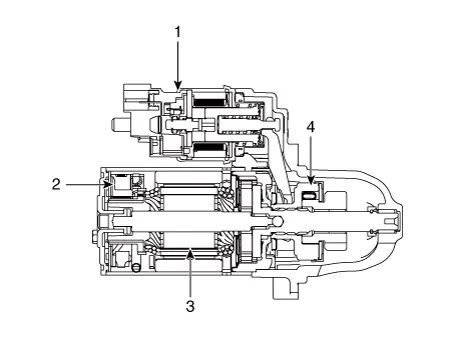
1. Solenoid
2. Brush assembly
3. Armature
4. Overrun clutch
| Item | Specification | |
| Rated voltage | 12V, 1.2kW | |
| The number of pinion teeth | 11 | |
| Performance | Ampere | Max. 80 A |
| [No-load, 11.0V] | Speed | Min. 3,100 RPM |
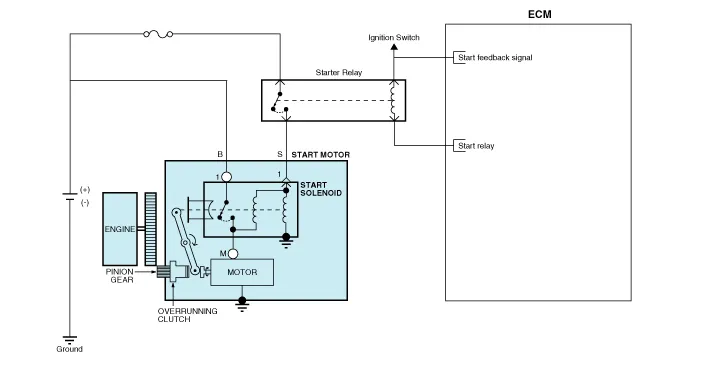
1.Turn the ignition switch OFF and disconnect the battery (-) terminal.
2.Remove the engine room under cover.(Refer to Engine Mechanical System - "Engine Room Under Cover")
3.Disconnect the starter ST connector (A).
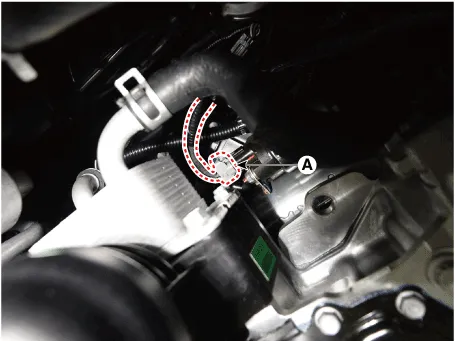
4.Remove the stater "B" terminal cable mounting nut (B).
Tightening torque :9.8 - 11.8 N.m (1.0 - 1.2 kgf.m, 7.2 - 8.7 Ib-ft)

5.Remove the air cleaner assembly.(Refer to Engine Mechanical System - "Air Cleaner")
6.Remove the starter mounting bolt (A).
Tightening torque :49.0 - 63.7 N.m (5.0 - 6.5 kgf.m, 36.2 - 47.0 Ib-ft)
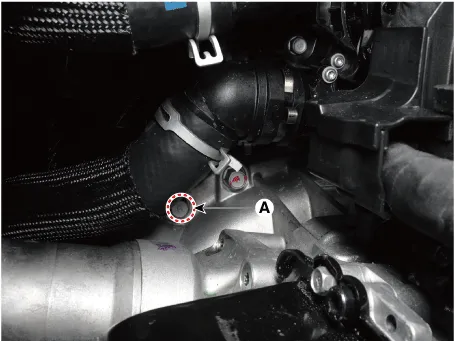
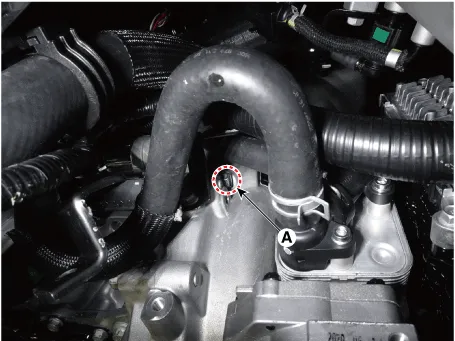
7.Remove the wiring bracket mounting bolt (A) and then disconnect the high flow electric oil pump (HF EOP) connector (B).

8.Remove the starter (A).
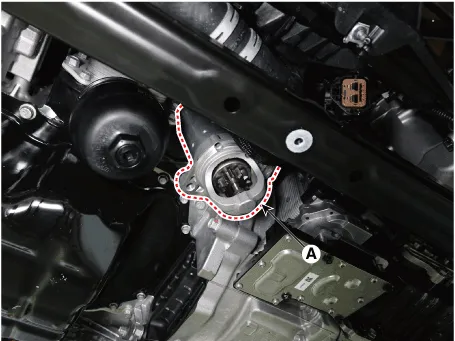
1.Install in the reverse order of removal.
1.Remove the M-terminal nut (A) on the magnetic switch assembly (B).

2.After loosening the screws (A), remove the magnetic switch assembly.
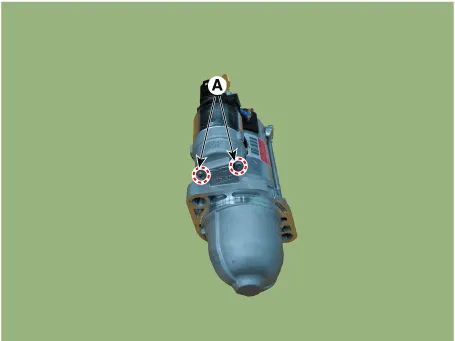
3.Remove the through bolts (A).
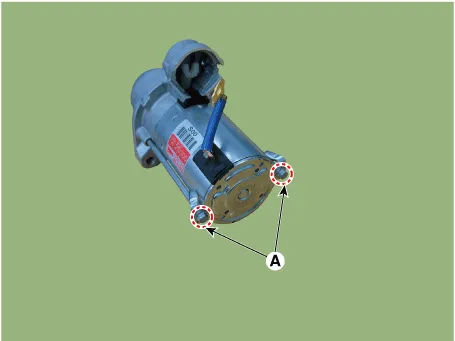
4.Remove the lever rest (A).
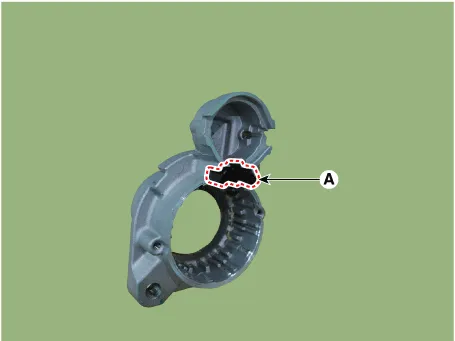
5.Remove the lever (A).
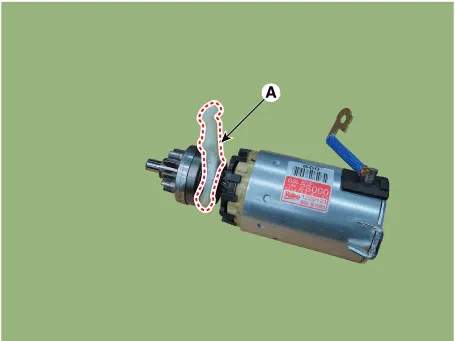
6.Remove the planet gear shaft assembly (A).
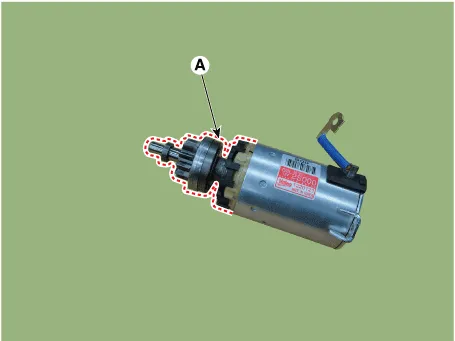
7.Remove the armature assembly & yoke assembly (A).
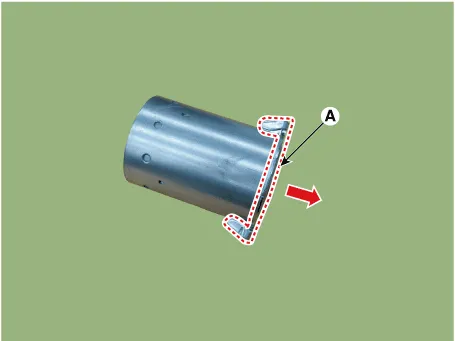
8.Remove the armature assembly (A) from the yoke assembly.
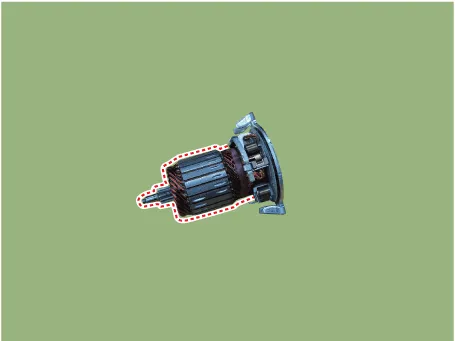
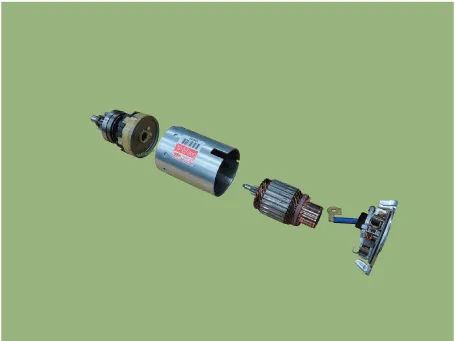
9.Remove the gasket sheet (A).
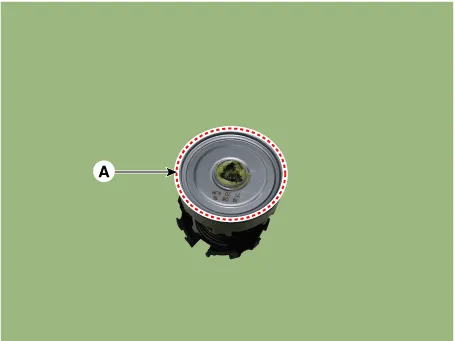
10.Remove the planet gears (A).
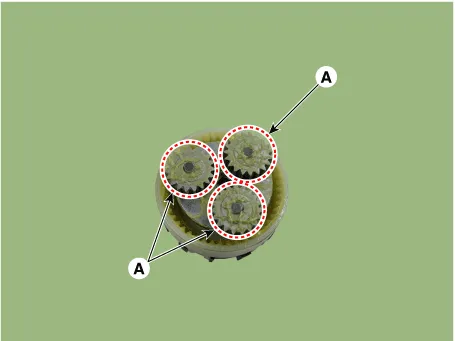
11.Press the stopper (A) using a socket (B).
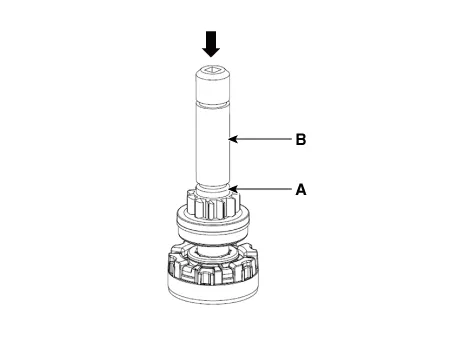
12.After removing the stop ring (A) using stop ring pliers (B).

13.Disconnect the stopper (A), overrunning clutch (B), internal gear (C) and drive shaft (D).
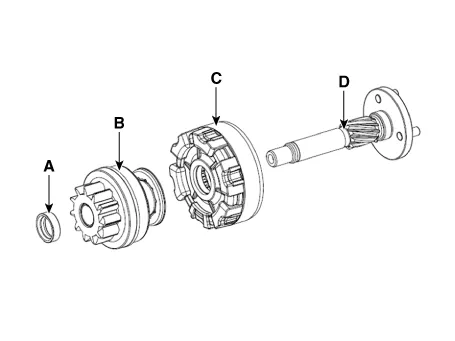

• Using a suitable pulling tool (A), pull the overrunning clutch stopper (C) over the stop ring (B).
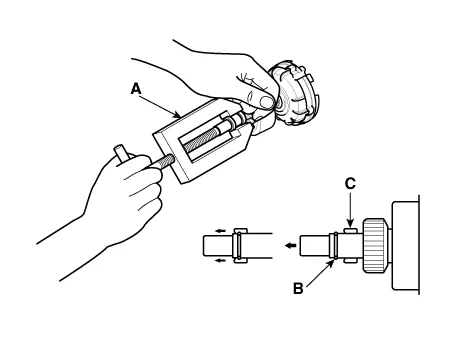
14.Reassembly is the reverse of disassembly.
1.Reassemble in the reverse order of disassembly.
1.Disconnect the lead wire from the M-terminal of solenoid switch.
2.Connect the battery as shown. If the starter pinion pops out, it is working properly.

• To avoid damaging the starter, do not leave the battery connected for more than 10 seconds.

3.Disconnect the battery from the M terminal.If the pinion does not retract, the hold-in coil is working properly.

• To avoid damaging the starter, do not leave the battery connected for more than 10 seconds.

4.Disconnect the battery also from the body. If the pinion retracts immediately, it is working properly.

• To avoid damaging the starter, do not leave the battery connected for more than 10 seconds.
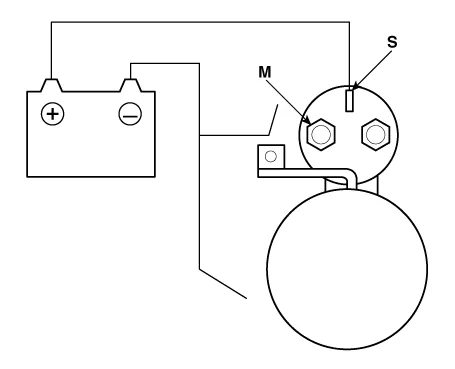
1.Place the starter motor in a vise equipped with soft jaws and connect a fully-charged 12-volt battery to starter motor as follows.
2.Connect a test ammeter (150-ampere scale) and carbon pile rheostats shown is the illustration.
3.Connect a voltmeter (15-volt scale) across starter motor.
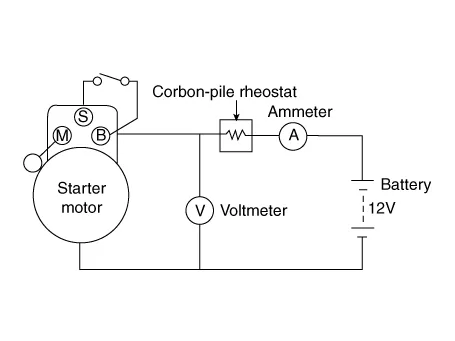
4.Rotate carbon pile to the off position.
5.Connect the battery cable from battery's negative post to the starter motor body.
6.Adjust until battery voltage shown on the voltmeter reads 11.5 and 11 volts.
7.Confirm that the maximum amperage is within the specifications and that the starter motor turns smoothly and freely.
| Items | Specification |
| Current (Max.) | Max. 100 A |
| Speed (Min.) | Min. 3,100 RPM |
1.Remove the starter.
2.Disassemble the starter as shown at the beginning of this procedure.
3.Inspect the armature for wear or damage from contact with the permanent magnet. If there is wear or damage, replace the armature.

4.Check the commutator (A) surface. If the surface is dirty or burnt, resurface with emery cloth or a lathe within the following specifications, or recondition with #500 or #600 sandpaper (B).
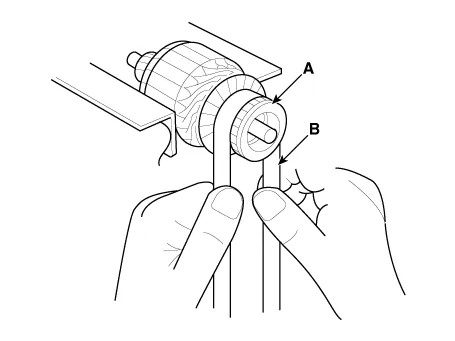
5.Measure the commutator (A) runout.
• If the commutator runout is within the service limit, check the commutator for carbon dust or brass chips between the segments.
• If the commutator run out is not within the service limit, replace the armature.
Commutator runoutStandard (New) : 0.05 mm (0.0019 in.) maxService limit : 0.08 mm (0.0031 in.)
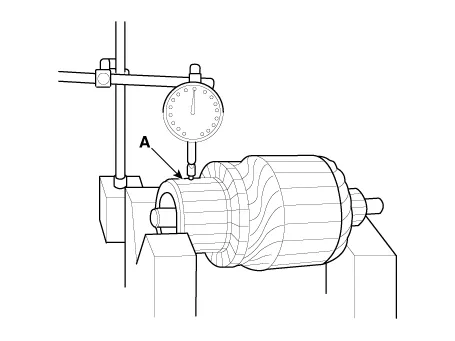
6.Check the mica depth (A). If the mica is too high (B), undercut the mica with a hacksaw blade to the proper depth. Cut away all the mica (C) between the commutator segments. The undercut should not be too shallow, too narrow, or v-shaped (D).
Commutator mica depthStandard (New) : 0.7 mm (0.0276 in.)Limit : 0.2 mm (0.0079 in.)
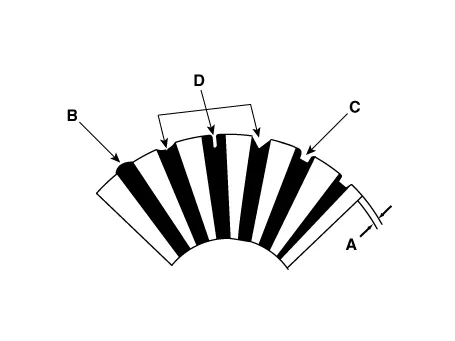
7.Check for continuity between the segments of the commutator. If an open circuit exists between any segments, replace the armature.
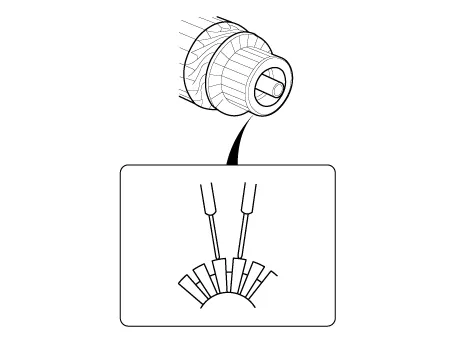
8.Check with an ohmmeter that no continuity exists between the commutator (A) and armature coil core (B), and between the commutator and armature shaft (C). If continuity exists, replace the armature.
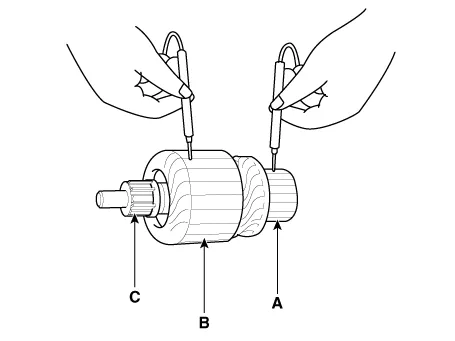
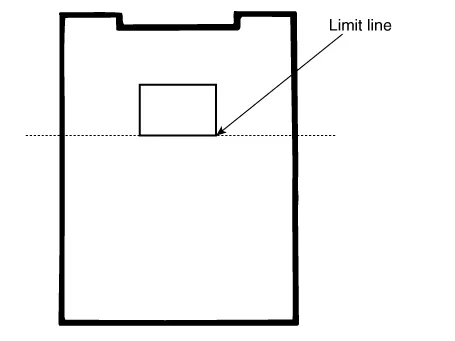
1.Check that there is no continuity between the (+) brush holder (A) and (-) plate (B). If there is continuity, replace the brush holder assembly.
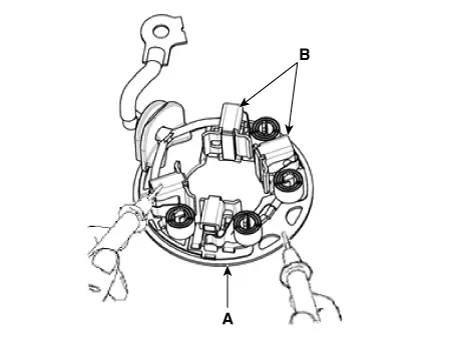
1.Slide the overrunning clutch along the shaft.Replace if it does not slide smoothly.
2.Rotate the overrunning clutch both ways.Does it lock in one direction and rotate smoothly in reverse? If it does not lock in either direction or locks in both directions, replace it.
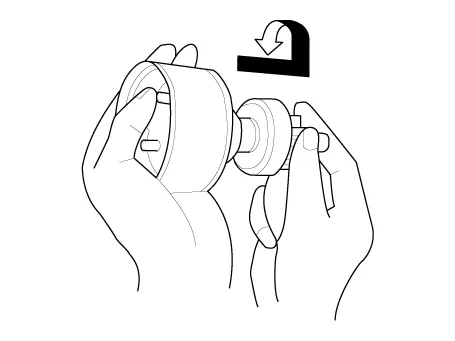
3.If the starter drive gear is worn or damaged, replace the overrunning clutch assembly. (The gear is not available separately.)Check the condition of the flywheel or torque converter ring gear if the starter drive gear teeth are damaged.
1.Do not immerse parts in cleaning solvent.Immersing the yoke assembly and/or armature will damage the insulation wipe these parts with a cloth only.
2.Do not immerse the drive unit in cleaning solvent. The overrun clutch is pre-lubricated at the factory and solvent will wash lubrication from the clutch.
3.The drive unit may be cleaned with a brush moistened with cleaning solvent and wiped dry with a cloth.
 Troubleshooting
Troubleshooting
- Troubleshooting
• The battery must be in good condition and fully charged for this troubleshooting.
Trouble symptomProbable causeRemedy
Engine will not crankBattery c ...
 Starter Relay
Starter Relay
- Inspection
1.Turn ignition switch OFF and disconnect the battery negative (-) terminal.
2.Remove the fuse box cover.
3.Remove the starter relay (A).
4.Check for continuity between the term ...
Other information:
Hyundai Santa Cruz (NX4A OB) 2021-2025 Service Manual: Front Impact Sensor (FIS)
- Description
• The front impact sensors (FIS) are installed on the upper of the
side panel in Front End Module (FEM). They are remote sensors that
detect acceleration due to a collision at their mounting locations.
• The primary purpose of the Front Impact Sensor (FIS) is to
provid ...
Hyundai Santa Cruz 2021-2025 Owners Manual: Hill-Start Assist Control (HAC)
Hill-Start Assist Control helps prevent
the vehicle from rolling backwards
when starting a vehicle from a stop
on a hill. The system operates the
brakes automatically for approximately
2 seconds and releases when the
accelerator pedal is depressed.
WARNING
Always be ready to depress the
accel ...
